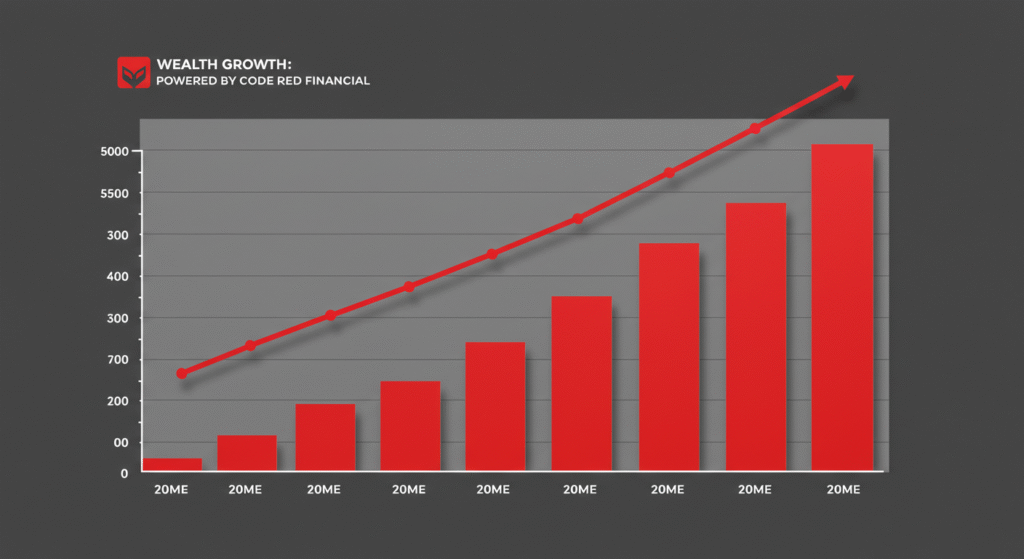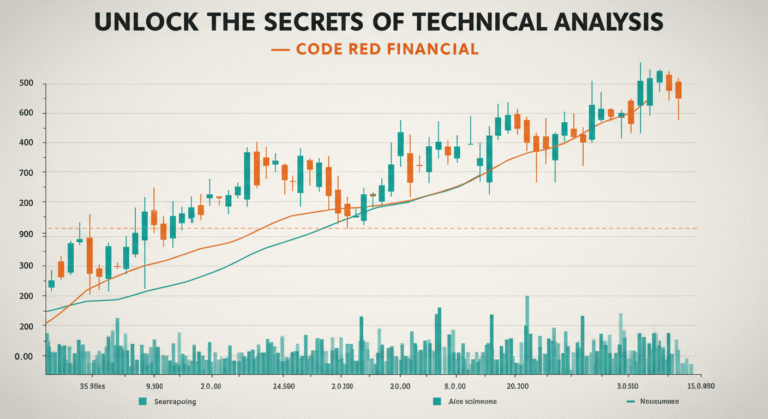
Investing Cheat Sheet-Part One
Is there such a thing as an investing cheat sheet, or in other words, a way for beginners to quickly learn and acquire the necessary skills to get into the investing arena without dedicating years to do so? I say yes. Now, before you start screaming at me at the top of your lungs, give me a chance to properly elucidate what I mean and just how precisely it can be achieved.
The goal here at Code Red Financial is to do much more than tell you about how great we are and what we have accomplished. The aim, as stated in our About page, is to keep you, the readers, as our primary focus with well-researched articles that are impactful not just with superfluous information, but more so with practical insights you can begin to apply to your lives right away.
So, what precisely is this investing cheat sheet, you ask? Well, I may have to deflate your enthusiasm just a bit, because there isn’t an investing cheat sheet for escaping the fundamentals of investing. However, what we do have is a compressed list of do’s and don’ts covering many of the most crucial points you need to know. This can help you avoid four years or more of finance college classes and provide practical insights to get you started. But it should be made clear, as with just about anything, learning is and should always be a continual process.
Let’s get started, shall we–
Some of the common misperceptions many harbors regarding investments or the world of finance are that their current lack of grasp is permanent and that some sort of fancy title or college degree is required to fully get in the game. The reality, however, is anything but.
I remember an old martial arts instructor, back when I was an active practitioner, saying, “The best way to get into something is to start from where you are.” The point being that too many of us exhaust our most precious resource, “time,” pondering endlessly while opportunity slips away and time becomes out of reach. So, let me say it: let’s start from where you are right now, whatever your skill set, whatever your income bracket. Let’s get this show on the road toward destination prosperity.
Cheat Sheet Redefined: The Do’s and Don’ts of Smart Investing for Beginners
Alright, so we’ve established that this isn’t about finding some magical, effort-free shortcut. Instead, think of this as your condensed guide, your “CliffsNotes” if you will, to navigating the investment world with more confidence and less overwhelm. This is about giving you the foundational pillars so you can build your financial house on solid ground.
Let’s dive into the crucial DO’S that will set you on the right path:
1. DO: Define Your “Why” – Your Financial Goals
Before you even think about what to invest in, you need to understand why you’re investing. This is, without a doubt, the most crucial first step. Are you investing for retirement in 30 years? A down payment on a house in 5 years? Your children’s education in 15 years? Or perhaps you’re aiming for financial independence sooner rather than later?
Your “why” dictates your investment strategy, your risk tolerance, and your timeline. Investing for a short-term goal (like that house down payment) will look very different from investing for a long-term goal like retirement.
- Actionable Insight: Grab a notebook (yes, a physical one can be powerful!) and write down your top 1-3 financial goals. Be specific. Instead of “get rich,” try “accumulate $X for a comfortable retirement by age Y” or “save $Z for a house deposit in X years.” This clarity is your compass. I personally review my “why” at least once a year to make sure my actions are still aligned with my deepest motivations. It keeps me grounded, especially when markets get a little wild.
2. DO: Understand Your Personal Risk Tolerance
This is a big one. Risk tolerance is your ability and willingness to stomach potential losses in your investments in exchange for the possibility of higher returns. If the thought of your investment portfolio dropping 10% in a month keeps you up at night, you likely have a lower risk tolerance. If you’re comfortable with volatility, knowing that historically, markets trend upwards over the long term, you might have a higher risk tolerance.
Several factors influence this: your age (younger folks can typically afford more risk), income stability, financial dependents, and your emotional constitution. There’s no right or wrong answer here; it’s about what’s right for you.
- Actionable Insight: Many online brokerage platforms offer risk tolerance questionnaires. Take a couple! Be honest with your answers. Understanding this will help you choose investments that align with your comfort level, preventing panic-driven decisions later. Remember, an investment strategy you can’t stick with is a losing strategy.
3. DO: Start Small, But Most Importantly, Start NOW
One of the biggest hurdles I see people face is the feeling that they need a substantial amount of money to even begin investing. This is a myth! Thanks to fractional shares, low-cost ETFs, and brokerage accounts with no minimums, you can start with as little as $50 or $100.
The magic ingredient here isn’t the initial amount, but time and the power of compound interest. Compound interest is essentially earning returns on your previous earnings. Albert Einstein purportedly called it the “eighth wonder of the world,” and for good reason. The earlier you start, even with small amounts, the more time your money has to grow exponentially.
- Actionable Insight: Challenge yourself to set aside a small, manageable amount from your next paycheck – say $25, $50, or $100 – and open an investment account. The act of starting is often the hardest part. Once you’re in, the momentum builds.

4. DO: Educate Yourself Continuously (But Don’t Get Paralyzed)
Yes, this “cheat sheet” is designed to get you going quickly, but the learning journey in investing never truly ends. The financial world is dynamic. Read reputable financial news sites, follow trusted financial educators (like us here at Code Red Financial, of course!), listen to podcasts, and consider books on investing fundamentals.
However, a word of caution: avoid “analysis paralysis.” It’s easy to get so bogged down in learning that you never actually take action. Learn enough to make informed decisions, start, and then continue learning as you go.
- Actionable Insight: Dedicate a small amount of time each week – maybe 30 minutes to an hour – to learning about one investing concept. Perhaps one week it’s understanding what an ETF is; the next, it’s learning about asset allocation. Small, consistent efforts compound your knowledge, just like your money!
5. DO: Embrace Long-Term Thinking
For most people, investing isn’t about getting rich quick; it’s about building sustainable wealth over time. The stock market, for example, can be volatile in the short term. There will be ups, and there will be downs. But historically, over extended periods (10, 20, 30+ years), the market has trended upwards.
If you’re investing for long-term goals, try not to get caught up in the daily noise or the “breaking news” that sends markets tumbling for a day or two. Focus on your long-term plan.
- Actionable Insight: When you make an investment, especially in broad market index funds or ETFs, tell yourself this is for the “future you” – 5, 10, or 20 years down the line. This mindset helps weather the inevitable short-term storms.
6. DO: Prioritize Paying Off High-Interest Debt
This might seem counterintuitive in an investing article, but it’s crucial. If you have credit card debt with an 18% or 25% APR, paying that off is often the best “guaranteed return” you can get. It’s unlikely your investments will consistently outperform such high interest rates, especially in the short term.
- Actionable Insight: Take stock of all your debts. List them out with their corresponding interest rates. Aggressively tackle the highest-interest ones first (this is often called the “debt avalanche” method). Once high-interest debt is managed, you’ll free up more cash flow for investing.
7. DO: Create and Stick to a Budget
Understanding where your money is going is fundamental to finding money to invest. A budget isn’t about restriction; it’s about awareness and control. It helps you identify areas where you can cut back non-essential spending and redirect those funds towards your investment goals.
- Actionable Insight: Use a budgeting app, a spreadsheet, or even a notebook. Track your income and expenses for a month to see your patterns. Then, create a plan that allocates funds for savings and investing. Treat your investment contributions like any other essential bill.
8. DO: Build an Emergency Fund
Life happens. Cars break down, medical emergencies occur, and unexpected job losses can derail the best-laid plans. An emergency fund is a stash of cash, typically 3-6 months’ worth of essential living expenses, kept in a readily accessible, liquid account (like a high-yield savings account).
This fund prevents you from having to sell your investments prematurely, potentially at a loss, when an unexpected expense arises.
- Actionable Insight: Calculate your essential monthly expenses. Multiply that by 3 to 6 to get your emergency fund target. Automate contributions to a separate savings account until you reach this goal. This should be a priority before or alongside aggressive investing.
9. DO: Understand Basic Investment Types
You don’t need to be an expert, but knowing the basics will go a long way.
- Stocks (Equities): When you buy stock, you’re buying a small piece of ownership in a company. Stocks offer the potential for high growth but come with higher risk.
- Bonds (Fixed Income): When you buy a bond, you’re essentially lending money to an entity (a government or corporation) in exchange for periodic interest payments and the return of the principal at maturity. Generally considered lower risk than stocks.
- Mutual Funds: These pool money from many investors to purchase a diversified portfolio of stocks, bonds, or other assets. They are professionally managed but often come with higher fees.
- Exchange-Traded Funds (ETFs): Similar to mutual funds, ETFs hold a basket of assets. However, they trade on stock exchanges like individual stocks. Many ETFs, especially index-tracking ETFs, have very low fees and are a fantastic option for beginners. Think of an S&P 500 ETF – it gives you instant diversification across 500 of the largest U.S. companies.
- Actionable Insight: For most beginners, starting with low-cost, broad-market ETFs (like those tracking the S&P 500 or a total stock market index) is an excellent and highly recommended strategy.
10. DO: Diversify, Diversify, Diversify!
You’ve heard the saying, “Don’t put all your eggs in one basket.” This is paramount in investing. Diversification means spreading your investments across different asset classes (stocks, bonds, real estate), industries, and geographies. If one investment performs poorly, others may perform well, cushioning the blow.
- Actionable Insight: Index funds and broad-market ETFs are inherently diversified. If you buy an S&P 500 ETF, you’re instantly invested in 500 different companies across various sectors. This is a simple way for beginners to achieve diversification without needing to pick individual stocks.
11. DO: Consider Dollar-Cost Averaging (DCA)
Dollar-Cost Averaging is an investment strategy where you invest a fixed amount of money at regular intervals (e.g., $100 every month), regardless of the share price. When prices are high, your fixed amount buys fewer shares. When prices are low, your fixed amount buys more shares.
This approach helps smooth out the average cost of your shares over time and removes the emotional temptation to try and “time the market” (which we’ll get to in the Don’ts).
- Actionable Insight: Set up automatic transfers from your bank account to your brokerage account on a regular schedule (e.g., monthly or bi-weekly). This “set it and forget it” approach instills discipline.
12. DO: Utilize Tax-Advantaged Accounts
Governments often provide tax incentives to encourage saving and investing for retirement. In the U.S., common examples include:
- 401(k) or 403(b): Employer-sponsored retirement plans. Contributions are often tax-deductible, and if your employer offers a “match,” contribute at least enough to get the full match – it’s free money!
- Traditional IRA: Contributions may be tax-deductible, and investments grow tax-deferred until withdrawal in retirement.
- Roth IRA: Contributions are made with after-tax dollars, but qualified withdrawals in retirement (including all earnings) are completely tax-free. This can be incredibly powerful!
- Actionable Insight: If your employer offers a 401(k) with a match, prioritize contributing enough to get that match. Then, explore opening a Roth IRA if you’re eligible.

Now, let’s pivot to the crucial DON’TS – the common pitfalls that can derail your investing journey:
1. DON’T: Try to Time the Market
This is a classic beginner mistake (and even seasoned pros struggle with it). Trying to predict short-term market movements – buying at the absolute bottom and selling at the absolute top – is a fool’s errand. Nobody can do it consistently. More money has been lost by investors trying to anticipate corrections than in the corrections themselves.
- Why it’s bad: You’re more likely to miss out on the market’s best days, which can significantly impact your long-term returns. Staying invested is generally the better strategy.
2. DON’T: Invest in What You Don’t Understand
If you can’t explain an investment to a friend in simple terms, you probably shouldn’t be putting your money into it. Complex derivatives, obscure cryptocurrencies with no clear use case, or that “hot stock” your cousin’s friend’s barber recommended – be wary. Understanding the underlying asset or strategy is key to making sound decisions.
- Why it’s bad: Lack of understanding leads to poor decision-making, especially when things go south. You won’t know whether to hold, sell, or buy more if you don’t grasp the fundamentals.
3. DON’T: Let Emotions Drive Your Decisions (Fear & Greed)
The two biggest enemies of an investor are fear and greed. Greed leads to chasing high-flying stocks at their peak, often just before a crash. Fear leads to panic selling when the market dips, locking in losses and missing the eventual recovery.
- Why it’s bad: Emotional investing is almost always a recipe for buying high and selling low – the exact opposite of what you want to do. Having a long-term plan and sticking to it helps mitigate emotional reactions.
4. DON’T: Chase “Hot Tips” or Fads
Whether it’s from a social media influencer, a friend, or a news headline, be incredibly skeptical of “guaranteed win” investments or stocks that are “going to the moon.” By the time you hear about a hot tip, the smart money has often already moved on.
- Why it’s bad: These tips often lack fundamental analysis and can lead to investing in speculative assets at inflated prices. Stick to your strategy and well-researched investments.
5. DON’T: Put All Your Eggs in One Basket (Reiterating Diversification)
I know we covered this in the “Do’s,” but it’s so critical it bears repeating as a “Don’t.” Don’t load up entirely on your company’s stock, or one “promising” tech company, or even a single industry. The fortunes of individual companies or sectors can change rapidly.
- Why it’s bad: Lack of diversification exposes you to concentrated risk. If that one company or sector falters, your entire portfolio can suffer significantly.
6. DON’T: Neglect Fees
Investment fees might seem small, but they can significantly erode your returns over time, especially with the power of compounding working against you. Pay attention to expense ratios on mutual funds and ETFs, trading commissions, and any advisory fees.
- Why it’s bad: A 1% difference in fees might not sound like much, but over 20 or 30 years, it can amount to tens or even hundreds of thousands of dollars in lost returns. Opt for low-cost options whenever possible.
7. DON’T: Compare Your Journey to Others’
Your financial situation, goals, risk tolerance, and timeline are unique to you. It’s easy to fall into the trap of comparing your investment returns to someone else’s, especially when they’re bragging about a big win. Focus on your own plan and progress.
- Why it’s bad: Comparison can lead to envy, taking on inappropriate risk, or feeling inadequate. Run your own race.
8. DON’T: Panic Sell During Market Downturns
Market downturns are a natural part of the investing cycle. When markets are falling, it’s tempting to sell everything to “stop the bleeding.” However, historically, markets recover. Selling during a downturn locks in your losses and means you miss out on the subsequent rebound.
- Why it’s bad: Panic selling is often the worst thing you can do. If your long-term goals haven’t changed and your investments are fundamentally sound (especially if you’re in diversified index funds), staying the course or even investing more (if you’re dollar-cost averaging) is usually the wiser move. I often remind myself during downturns that I’m buying quality assets “on sale.”

The Path Forward: Your First Steps
Phew! That was a lot, I know. But consider this your foundational “cheat sheet” condensed. The journey to becoming a confident investor is a marathon, not a sprint.
So, what now?
- Revisit Your “Why”: Seriously, do this first.
- Assess Your Financial Health: Emergency fund? High-interest debt? Budget?
- Educate Yourself a Little More: Focus on understanding low-cost index ETFs.
- Choose a Brokerage: Look for reputable, low-fee online brokers. Many are great for beginners (e.g., Vanguard, Fidelity, Charles Schwab, or newer platforms like M1 Finance or Robinhood – just be aware of the pros and cons of each).
- Open an Account: Start with a Roth IRA if it makes sense for your situation, or a taxable brokerage account.
- Make Your First Investment: Even if it’s just $50 into a broad stock market ETF. The experience is invaluable.
- Automate It: Set up those regular contributions.
I genuinely believe that with these principles, you’re far better equipped than many who dive in without a plan. You’re avoiding the “four years of finance college” by focusing on the distilled wisdom that truly matters for long-term success.
Remember that old martial arts instructor? He also used to say, “A black belt is just a white belt who never quit.” The same applies to investing. Start where you are, with what you have, commit to continuous learning, and stay the course. Destination prosperity isn’t a pipedream; it’s a result of consistent, informed action.
We’re here at Code Red Financial to help you along that journey. This isn’t just information; it’s an invitation to take control of your financial future. You’ve got this!
Disclaimer: This article is for informational purposes only and should not be considered financial or investment advice. Investing in any of the mentioned passive income streams involves risk, and you could lose money. Before making any investment decisions, it is essential to conduct your own thorough research and consider consulting with a qualified financial advisor who can assess your individual financial situation, risk tolerance, and goals. The potential returns discussed are illustrative and not guaranteed. Market conditions, regulations, and other factors can significantly impact the performance of any investment or business venture.




